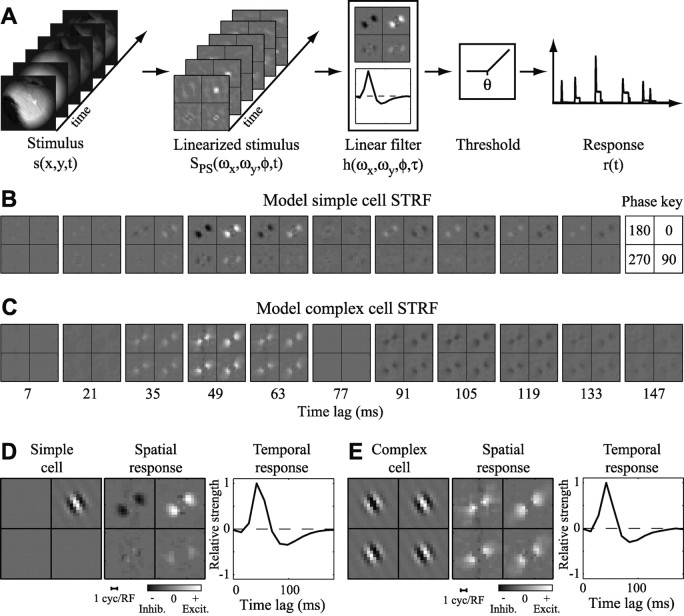Figure 2.
Linearized STRF model. The phase-separated Fourier model incorporates a nonlinear spatial transformation at its input stage to account for response properties of both simple and complex cells. A, Visual input is the time-varying sequence of gray scale images at the left. The stimulus is Fourier-transformed and projected onto quadrature spatial phase channels according to Equation 2. The transformed stimulus is convolved with a spatiotemporal filter and thresholded according to Equation 1 to produce the instantaneous firing rate, r(t). B, STRF estimated using natural vision movie data for a model simple cell. Brighter regions indicate input channels correlated with an increase in firing (excitation), whereas dark regions indicate channels correlated with a decrease in firing (inhibition). At each time lag, the four subpanels show spatial frequency and orientation tuning at four spatial phases (key at far right). Spatial frequency and orientation are plotted in the Fourier domain. Radial position in the subpanel corresponds to spatial frequency, and angle corresponds to orientation. For this neuron, excitatory responses are confined to the top right subpanel, consistent with the fact that the model simple cell had even, on-center spatial phase tuning. The top left subpanel reveals inhibition at a 180° phase offset, reflecting the linear phase tuning of the simple cell. C, STRF estimated for a model complex cell. Spatial and temporal tuning resemble that in B, except all four phase channels drive excitatory responses. D, Spatial (middle) and temporal (right) response functions for the simple cell STRF in B. At left is the Gabor function showing the actual spatial tuning of the model simple cell. The spatial response function shows excitatory tuning at the phase corresponding to the even, on-center Gabor. E, Spatial and temporal response functions composing the complex cell STRF in C. The model complex cell is excited by spatial patterns matching any of the four Gabor functions at the left. Thus, all four phase channels indicate excitatory tuning at the corresponding orientation and spatial frequency. Inhib., Inhibition; Excit., excitation.

